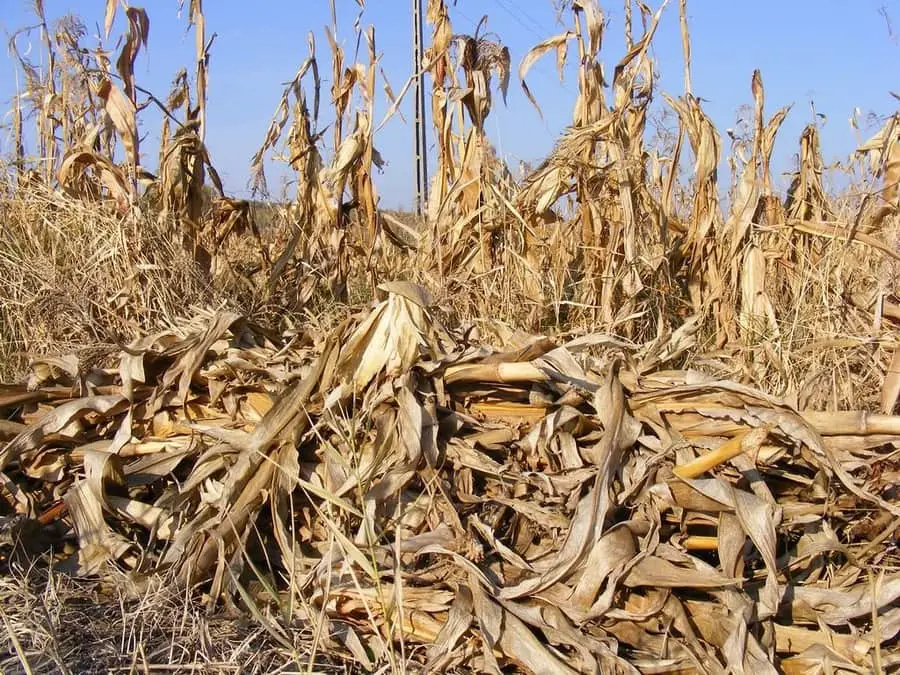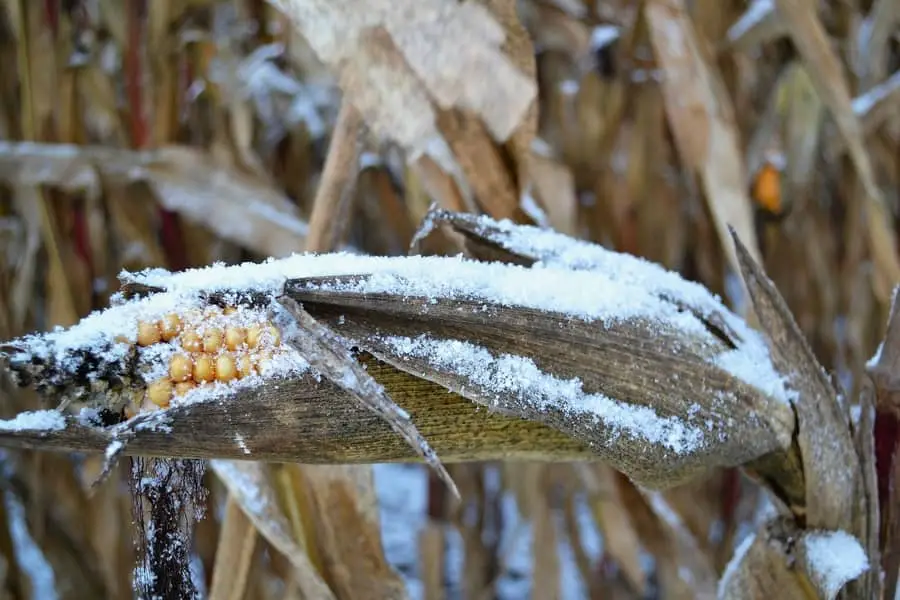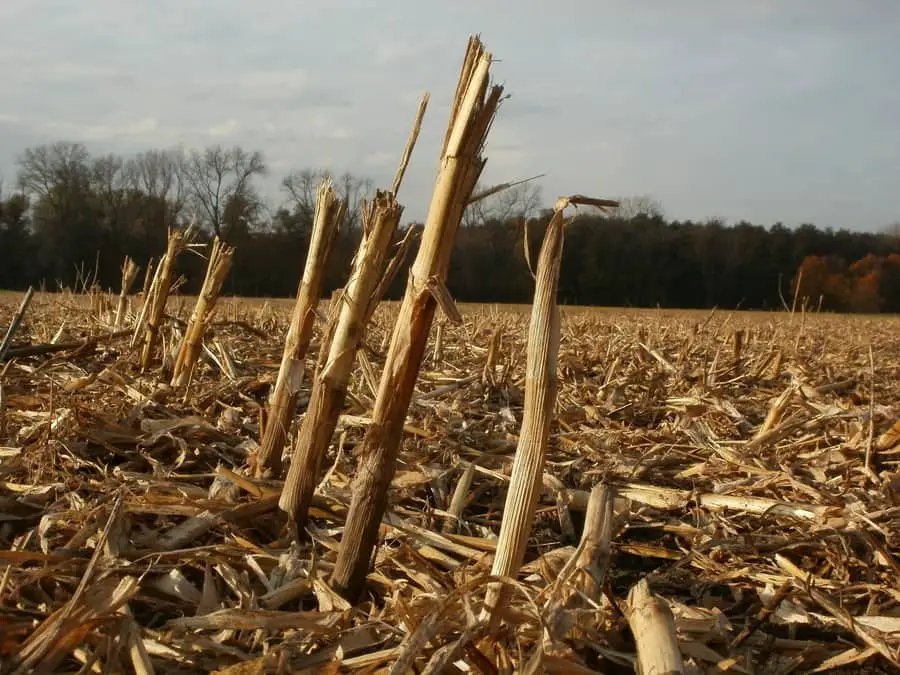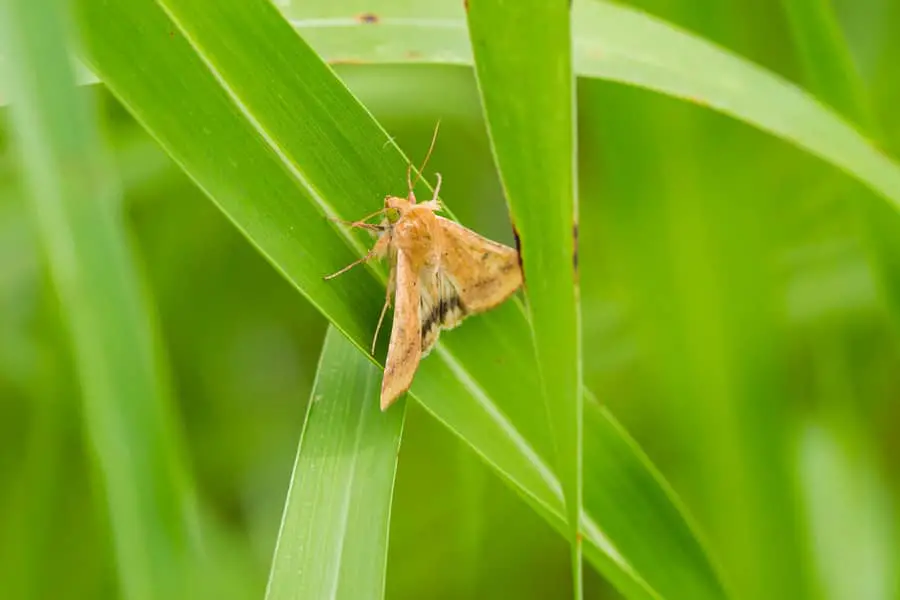
Growing and eating fresh corn is one of the perks of gardening, but the old stalks that remain once you’ve harvested can cause a bit of a problem. Should you get rid of them, or leave them up through the winter?
What can you do with dead corn stalks after harvest? Corn stalks can be repurposed as mulch, compost, decorations, or feed for animals. You are saving yourself from potential bug outbreaks, garden eyesores, and ensure that your soil stays nice and healthy by removing the stovers before winter.
Table of Contents
What can you do with sweet corn stalks after harvest

A lot of people use the stalks to create fun Autumn and Halloween decorations. This is as easy as drying the stalks after they have been cut by hanging them upside down in the sun. This will take about 5 days, after which they turn a beautiful fall gold color. You can turn them into decorations by wrapping bundles up in ribbon or twine and placing them anywhere in our outside your home.
Animals like cows, horses, and pigs will always be grateful to have your corn stalks as food or bedding. They will eat the entire stalk, from the corn grain to the husks, leaves, and the stalk. They should be fed other things in addition to stalks to ensure nutritional balance.
You can also use corn stalks as part of compost along with other fresh and dry plant debris, and other organic materials. Stiff corn stalks will take some time to break down, but paired with leaves, husks, and corn cobs, you will still make a successful compost.
Mulch is an important component in any garden, and it serves a variety of purposes. It prevents soil from becoming compacted and hard, keeps weeds to a minimum, insulates soil temperate in warm and cool weather, and prevents evaporation. Corn husks make fantastic mulch because it is resistant to being compact and will remain loose even with a lot of pressure. It is also fire resistant, unlike bark, which is the most common form of mulch, and it is heavy enough to withstand most types of weather.
Are there any Benefits to keeping dead corn stalks

Leaving stalks up does have some benefits too. Most notably that it will catch snow which cuts down on soil erosion, but this will only be of benefit if you have a decent number of stalks up. You’ll see many commercial farmers leave their stalks up during the winter, and that is both to catch snow and to make the work of their farming equipment easier.
For backyard farmers, the better option is taking them down and putting them to use elsewhere. Goats, horses, and pigs love to eat them, so they could become food for neighboring animals. They also have a range of other potential uses around your home and garden.
When should you pull up corn stalks

After the corn is freshly harvested, the stalks need time to dry; otherwise, you will lift the residue out of your soil. You want to wait until the stalks dry out a little until their leaves are just about to fall. Then you can harvest them by cutting the stalks close to the ground. This means that you’ll be able to use the stalks without having to deal with the roots.
You can then choose to take the roots out or leave them in. Many gardeners recommend keeping the roots of plants to cultivate and feed beneficial soil microbes. Worms and bacteria will eat at the roots, which put good bacteria back into the soil, aiding the recovery of the soil. You can choose to take the stalks out and replenish the soil manually as well. If you want to take the roots out, you can dig them out with a shovel, taking care to shake excess dirt back onto the soil.
Why you should get rid of Cornstalks

If you don’t get rid of cornstalks, you leave yourself open to outbreaks of sap beetles. You want to get rid of the whole stalk and the root if you do not use any pesticides. The issue is the depletion of soil each year after harvest. As previously stated, roots help feedback essential nutrients into the soil, so you will need to consider this.
The main reason you would want to get rid of the cornstalk above the surface is the multitude of other uses they have. Other than collecting snow in the winter, empty corn husks only serve as a garden eyesore.
Soil quality has a huge impact on your gardening yields, and the time after you have harvested your crops is the best time to replenish any deficiencies in the soil. This is very difficult if you are trying to work around tall stalks of corn. If you remove them, you can test your soil and rectify any deficiencies much more easily.
Tips to grow healthy corn year after year

You can use your corn husks to grow healthy corn year after year. Pullin gup corn stalks and taking steps to ensure healthy soil can help you grow great crops come next spring. However, it is not advised that you plant your corn plants in the same spot each year.
Corn is pretty robust and will grow in various conditions, but the one thing it is a little picky about is soil. They prefer that their soil be enriched with aged manure or compost the fall before planting, which will allow it to overwinter in the soil.
You’ll always want to pick a spot that gets good sunlight and that has soil with a neutral pH level. Corn, despite growing anchoring roots around the surface of the plant, will also grow roots deep below the surface. This means that you will want to water corn less frequently and in a larger quantity.
Corn seedlings are, unfortunately, a favorite snack for pests like cutworms, corn earworms, and flea beetles. These are particularly prevalent in the south and central parts of the US. You can prevent these naturally by using an eyedropper or spray bottle and fill it with a mixture of vegetable oil, Bt (Bacillus thuringiensis), water, and a few drops of dishwashing liquid. Apply this mixture to each ear every few days. You could also try pinning a clothespin to the tip of your ear of corn when the skills turn brown to stop the worms from getting through to the ear.
Corn is ready to pick when the corn looks fat, with dark green ears and brown tassels. You can squeeze the corn to test how firm it is and see if it has a rounded tip. The last test you can do is poke a kernel with your fingernail. If the kernel spurts milky liquid, then it’s good to go. You’ll want to eat or preserve your corn very soon after picking.
